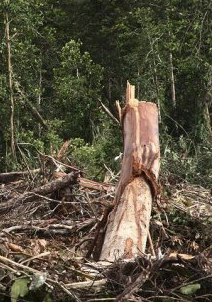Even small logging slugs species
 Taking a just a few trees from a tropical forest reduces biodiversity, a study shows, suggesting that “selective logging” may not be a sustainable practice.
Taking a just a few trees from a tropical forest reduces biodiversity, a study shows, suggesting that “selective logging” may not be a sustainable practice.
A new study looked at the impacts of logging on different groups of animals found in tropical forests, comparing the intensity of the logging with the decline in biodiversity.
Researchers used the data to establish thresholds of logging intensity, beyond which species are lost.
The team of Australian, Swiss and United States scientists found that mammals and amphibians were most sensitive to logging.
They found that number of mammal species would be halved at logging intensities of just 38 cubic metres per hectare (taking just 3 or 4 large trees from every hectare). Amphibians fared slightly better, with their species halved by 63 cubic metres of logging (about 6 to 7 large trees) per hectare.
“Selective logging is becoming increasingly common throughout the world's tropical forests,” says co-author Associate Professor Lian Pin Koh, from the University of Adelaide.
“While the effects of deforestation are pretty clear, the impact of selective logging on forest biodiversity is still poorly understood and, most likely, commonly underestimated.”
The international team analysed data from 48 published studies to quantify the impact of various logging intensities on biodiversity.
They found that most groups of animals were resilient under logging intensities of 10 m3 per hectare (about one large tree a hectare) or less.
Above this intensity, biodiversity was reduced.
“Tropical forests around the world are being lost at an alarming rate and the remaining forest is being degraded by selective logging,” said Associate Professor Koh.
“We hope our findings will help policymakers in the timber producing countries develop more sustainable logging practices to reduce the impacts on biodiversity.”








 Print
Print